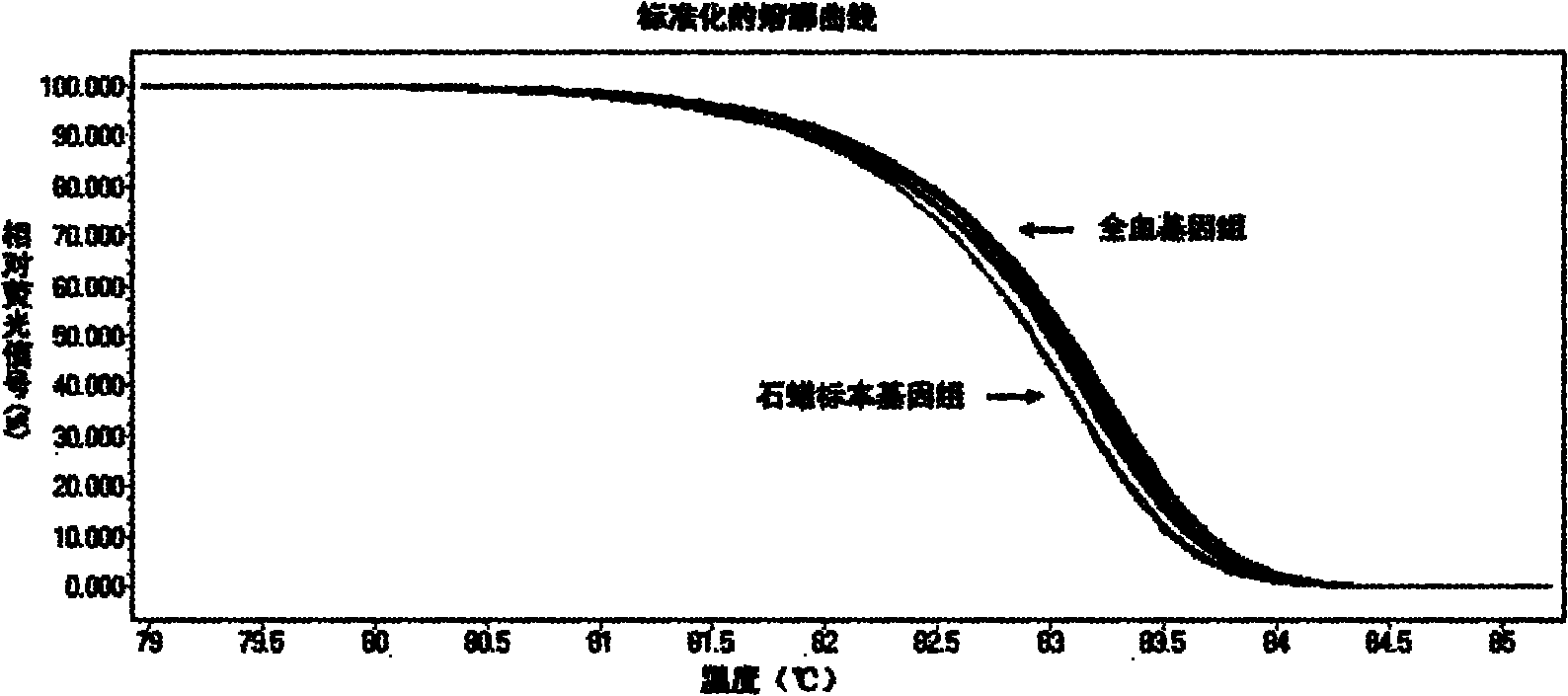Method and kit for detecting KRAS gene mutations in human colon and rectum cancers
A colorectal cancer, human detection technology, applied in the field of gene mutation detection, can solve problems such as indistinguishable
- Summary
- Abstract
- Description
- Claims
- Application Information
AI Technical Summary
Problems solved by technology
Method used
Image
Examples
Embodiment 1
[0059] Example 1: Selection of samples and extraction of genomic DNA
[0060] The collected genomic DNA comes from whole blood, cells, fresh tissue, and paraffin-fixed tissue. The extraction method refers to the operation manual provided by the kit, and some optimizations have been made at the same time.
[0061] Whole blood genomic DNA of healthy people was used as the wild-type control of the experiment, and was extracted using the BloodGen Mini Kit of Kangwei Century;
[0062] Genomic DNA derived from the A549 cell line was used as a homozygous mutant (G34A) control for the experiment,
[0063] The genomic DNA derived from the HCT116 cell line was used as the heterozygous mutant (G38A) control of the experiment, and was extracted using the DNA FlexGen DNA Kit of Kangwei Century;
[0064]Both fresh tissue and paraffin tissue were derived from mice, used to evaluate the adaptability of the HRM method to fixed tissue, and extracted using DNA TissueGen DNA Kit of Kangwei Centu...
Embodiment 2
[0069] Example 2: Identification of mutation sites
[0070] The samples with known KRAS 12 and 13 codon genotypes were detected by HRM technology.
[0071] . Specific primers and probes are as follows:
[0072] SEQ ID No: 1, forward primer 1: 5'-GCCTGCTGAAAATGACTGAA-3'
[0073] SEQ ID No: 2, reverse primer 1: 5'-TATCGTCAAGGCACTCTTGC-3'
[0074] SEQ ID No: 7, specific probe: 5'-CTCTTGCCTACGCCACCAGCTCCAACT-3'.
[0075] . Amplify the fragments near codon 12 / 13 by PCR; prepare the mixture: add 1 μl of the previously prepared genomic DNA solution, 2 μl PCR buffer (10×), 1.6 μl dNTP, 0.1 μl HotStarTaq DNA polymerase, forward primer 0.4 μl and 0.08 μl of reverse primer, 2 μl of SYTO 9 fluorescent dye, and PCR-grade pure water were added to make the reaction volume 20 μl. Reaction at 95°C for 15 minutes, 95°C for 15 seconds, 60°C for 15 seconds, 72°C for 15 seconds for 20 cycles, 81°C for 15 seconds, 60°C for 15 seconds, 72°C for 15 seconds for 15 cycles, 72°C for 2 Minutes; af...
Embodiment 3
[0079] Example 3: Kit Sensitivity Verification
[0080] The A549 homozygous mutant genome was mixed with the wild-type genome extracted from whole blood in a certain proportion, so that the A549 genome accounted for 0.05% of the total DNA amount. The concentration of the above mixed genomic DNA and wild-type genomic DNA was adjusted to 10 ng per microliter.
[0081] . Specific primers are as follows:
[0082] SEQ ID No: 1, forward primer 1: 5'-GCCTGCTGAAAATGACTGAA-3'
[0083] SEQ ID No: 2, reverse primer 1: 5'-TATCGTCAAGGCACTCTTGC-3'
[0084] SEQ ID No: 7, specific probe: 5'-CTCTTGCCTACGCCACCAGCTCCAACT-3'.
[0085] . Amplify a fragment near the 12 / 13 codon by PCR; prepare a mixture: add 1 μl of the previously prepared genomic DNA solution, 2 μl of PCR buffer (10×), 1.6 μl of 2.5mM dNTP, 0.1 μl of HotStarTaq DNA polymerase, forward 0.4 μl of primer and 0.08 μl of reverse primer, 2 μl of SYTO 9 fluorescent dye, 200 nM of specific probe, and PCR-grade pure water were added ...
PUM
| Property | Measurement | Unit |
|---|---|---|
| Sensitivity | aaaaa | aaaaa |
| Sensitivity | aaaaa | aaaaa |
Abstract
Description
Claims
Application Information
 Login to View More
Login to View More - R&D
- Intellectual Property
- Life Sciences
- Materials
- Tech Scout
- Unparalleled Data Quality
- Higher Quality Content
- 60% Fewer Hallucinations
Browse by: Latest US Patents, China's latest patents, Technical Efficacy Thesaurus, Application Domain, Technology Topic, Popular Technical Reports.
© 2025 PatSnap. All rights reserved.Legal|Privacy policy|Modern Slavery Act Transparency Statement|Sitemap|About US| Contact US: help@patsnap.com



